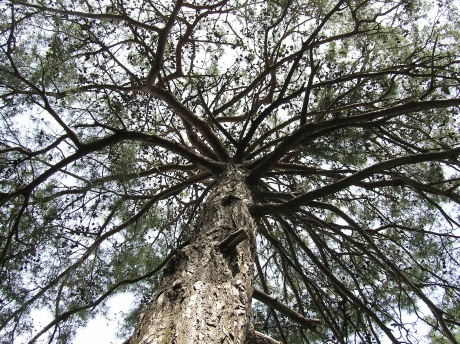zurück Rhodos
Blumen
last
Blumen 11
next

Aleppokiefer Rhodos
The
Aleppokiefer (or Aleppo Pine,
scientifically known as Pinus halepensis)
is a species of pine tree native to the
Mediterranean region, particularly in areas such as
Syria,
Turkey,
Lebanon,
Israel, and
Greece. The tree is named after
the city of Aleppo in Syria, as
it is common in the surrounding areas.
Key
Features of Aleppo Pine (Aleppokiefer):
1.
Appearance:
-
Height: Aleppo pines can grow up to
20–25 meters (66–82 feet)
tall, though they may grow shorter in certain environments.
-
Bark: The bark of the Aleppo pine is
grey-brown and becomes more
scaly and
flaky as the tree matures.
-
Needles: The needles are typically
long, about
7-12 cm (2.8-4.7 inches) in
length, and are paired in
clusters of two. They are a dark
green color, which is characteristic of many pine species.
-
Cones: The tree produces
small to medium-sized cones
that are brown when mature
and typically range from 5–10 cm
(2–4 inches) in length.
2. Habitat and Distribution:
- The Aleppo pine is primarily found in
dry, rocky, and hilly areas
across the Mediterranean, often in regions with a
hot, dry climate. It can
be found growing in coastal areas, forests, and mountainous regions.
- The species is tolerant of a variety
of soils, though it prefers well-drained, sandy soils and is resistant to
drought conditions, making it a common tree in Mediterranean landscapes.
3. Ecological Importance:
- Aleppo pines play an important role in
the Mediterranean ecosystem,
providing habitat for wildlife and contributing to the
stabilization of soil in
areas prone to erosion.
- The trees are also known to
resist fire to some
extent, which is a crucial trait in fire-prone Mediterranean climates. The
cones of the Aleppo pine require
high heat to open and release seeds, a process that often occurs
after forest fires, allowing the species to regenerate.
4. Uses:
-
Wood: The wood of the
Aleppo pine is soft, light, and has a low density, which makes it suitable
for use in construction, furniture, and paper production. It is not
typically used for high-end carpentry but is utilized in various industries
where its characteristics are appropriate.
-
Resin: Aleppo pines
produce pine resin, which
can be harvested and used in products such as turpentine and rosin.
-
Landscaping: Due to its
attractive form and ability to withstand dry conditions, the Aleppo pine is
often used in landscaping projects, particularly in Mediterranean and arid
climates.
5. Cultural and Historical Significance:
- The Aleppo pine has been historically
important to the people of the Mediterranean region. In ancient times, it
was used for timber, resin, and even in some
ceremonial practices.
- It is often associated with
traditional Mediterranean
landscapes, and many local cultures in the region have relied on
the Aleppo pine for various purposes for centuries.
6. Conservation Status:
- While the Aleppo pine is not
considered endangered, it has been threatened in some areas due to
deforestation,
urbanization, and the
impact of wildfires.
However, efforts to conserve the species and protect Mediterranean forests
have helped preserve its populations.
In Conclusion:
The Aleppokiefer (Aleppo Pine)
is a versatile and resilient tree species native to the Mediterranean region.
Known for its ability to withstand harsh conditions such as drought and fires,
it plays a significant ecological role and has been historically important for
the local population. Whether in forests, coastal areas, or urban landscaping,
the Aleppo pine continues to be a prominent and useful tree in Mediterranean
landscapes.
 26.07.25 Copyright Dirk
Rauschenbach Koelnerstrasse 293 51702 Bergneustadt
Datenschutzerklaerung 02261 9788972 Mail ccooly(
at) web.de
26.07.25 Copyright Dirk
Rauschenbach Koelnerstrasse 293 51702 Bergneustadt
Datenschutzerklaerung 02261 9788972 Mail ccooly(
at) web.de
 Safaris
Bergsteigen
Wandern
Inselwandern Weltweit
Safaris
Bergsteigen
Wandern
Inselwandern Weltweit
 Europa
Inselwandern
Europa
Inselwandern
 Städtewandern
Städtewandern
 Paintings
Paintings Dirk Rauschenbach
Dirk Rauschenbach
 Safaris
Bergsteigen
Wandern
Inselwandern Weltweit
Safaris
Bergsteigen
Wandern
Inselwandern Weltweit
 Europa
Inselwandern
Europa
Inselwandern
 Städtewandern
Städtewandern
 Paintings
Paintings Dirk Rauschenbach
Dirk Rauschenbach

![]() 26.07.25 Copyright Dirk
Rauschenbach Koelnerstrasse 293 51702 Bergneustadt
Datenschutzerklaerung 02261 9788972 Mail ccooly(
at) web.de
26.07.25 Copyright Dirk
Rauschenbach Koelnerstrasse 293 51702 Bergneustadt
Datenschutzerklaerung 02261 9788972 Mail ccooly(
at) web.de